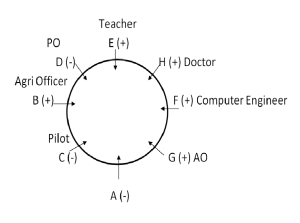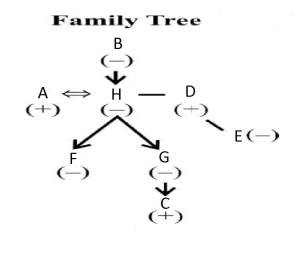Q. (1-5): Study the following information carefully and answer the questions given below:
A, B, C, D, E, F, G and H are sitting around a circular table facing the centre. Each has different professions – Teacher, Doctor, PO, AO, Lawyer, Agri Officer, Computer Engineer and Pilot – but not necessarily in the same order. B sits second to the left of H’s husband, who is neither an AO nor a Computer Engineer. No female is an immediate neighbour of B. D’s daughter sits second to the right of F and on the immediate left of PO. F, who is sister of G, is a Computer Engineer. F is not an immediate neighbour of H’s husband. D’s daughter is a Teacher. Only one person is sitting between A and F. H’s brother D sits on the immediate left of his mother, who is an Agri officer. A is the father of G. Only one person sits between H’s mother and E. E sits on the immediate right of the person who is a Doctor. Only one person sits between H and G. G sits second to the right of the person who is a pilot. G is mother of C and not an immediate neighbour of E.
1. Who amongst the following is D’s daughter?
1) B
2) C
3) E
4) G
5) H
2. Four of the following five are alike in a certain way based on the given information and so form a group. Which is the one that does not belong to that group?
1) F
2) C
3) E
4) H
5) G
3. The person who is a Lawyer is sitting between which of the following persons?
1) Teacher and AO
2) Agri officer and Teacher
3) Doctor and PO
4) Can’t be determined
5) None of these
4. Who among the following is a Pilot?
1) Can’t be determined
2) Mother of C
3) C
4) A
5) None of these
5. What is the position of A with respect to his grandson?
1) Immediate left
2) Third to the right
3) Immediate right
4) Second to the right
5) Fourth to the left
Q(6-10): In each question below are given two/three statements followed by two conclusions numbered I and II. You have to take the given statements to be true even if they seem to be at variance with commonly known facts. Give answer as
1) if only conclusion I follows.
2) if only conclusion II follows.
3) if either conclusion I or II follows.
4) if neither conclusion I nor II follows.
5) if both conclusions I and II follow.
(6-7): Statements:
No copy is a book.
Some books are magazines.
All papers are copies.
6. Conclusions:
I. No copy is a magazine.
II. No book is a paper.
7. Conclusions:
I. All copies being magazines is a possibility.
II. No magazine is a paper.
(8-9): Statements:
All elections are dramas.
All elections are stories.
Some dramas are not films.
8. Conclusions:
I. No film is a story.
II. Some films which are dramas are also stories.
9. Conclusions:
I. All films being elections is a possibility.
II. Some stories which are not elections are dramas.
10.Statements:
Some weeks are years.
All months are weeks.
All years are decades.
No hour is a month.
Conclusions:
I. All hours being decades is a possibility.
II. Some hours can never be years.
ANSWERS WITH EXPLANATIONS:
1)3
2)2
3)5
4)3
5)3
6)2
7)1
8)4
9)1
10)1
THANK YOU 🙂 🙂 🙂












